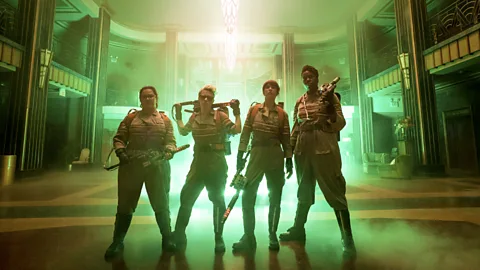Ghostbusters is a landmark in mainstream entertainment
 Columbia Pictures
Columbia PicturesIt’s a goofy and efficient franchise-starter that could do with more jokes, but the new Ghostbusters is daringly progressive, writes Nicholas Barber.
It’s fair to say that 1984’s Ghostbusters wasn’t a documentary, or even a Ken Loach-influenced social-realist drama about the working-class struggle against demons from another dimension. But Ivan Reitman’s much-loved 1984 action-comedy did have a certain grungy naturalism, and that was an essential part of its genius.
The joke was that even while New York was being plagued by slimy green phantoms, the four guys catching those phantoms were slobs with cigarettes hanging out of their mouths, living in a recognisable city populated by ordinary people.

It’s that grounding in workaday reality that is missing from Paul Feig’s cartoonish remake. Clogged up by cameo appearances by the original film’s actors, and verbal riffs that are all too obviously the work of comedians rather than people being confronted by the undead, the new Ghostbusters can’t stop winking at the audience and reminding us how goofy it is. It’s an upbeat and efficient franchise-starter with a few enjoyable gags, but it’s impossible to care about any of it.
Structurally, it’s spookily similar to Reitman’s film, although in the promising opening act it seems as if Feig and his co-writer, Katie Dippold, are venturing off into their own territory. Instead of replicating any of the 1984 characters, they introduce Erin Gilbert (Kristen Wiig), a diffident physics professor. She is on the verge of being granted tenure at Columbia University when her boss (Charles Dance) hears about the skeleton in her closet: she once believed in ghosts so fervently that she wrote a book about them with a schoolfriend, Abby Yates (Melissa McCarthy), who is now a paranormal researcher.
Erin is peeved that Abby has started selling the book online (“I thought I’d burnt both copies,” she mutters). But after the two old buddies witness a spectre in a Victorian mansion - the ectoplasm-spewing equivalent of the library ghost in the original film - they immediately put aside their differences, and go into the ghostbusting business.
Not that they had many differences in the first place. The trouble with Erin and Abby as characters is that they are too similar: despite that brief initial friction, they’re both amiable, enthusiastic nerds. The other characters have their problems, too. One is Patty Tolan (Leslie Jones), a sassy subway worker whose encyclopedic knowledge of the city’s history is laboriously set up, and then never utilised.
Another is Abby’s obnoxiously eccentric lab partner, Jillian Holtzmann (Kate McKinnon), who doesn’t have a personality so much as a stack of affectations: silly voices, punky hair, Tank-Girl-meets-Annie-Hall wardrobe. Only slightly less irritating is the women’s handsome-but-stupid receptionist, Kevin (Chris ‘Thor’ Hemsworth), who gets a lot of screen time for someone who doesn’t progress beyond the handsome-but-stupid designation he is given in his introductory scene.
Plot-wise, Kevin is a combination of the characters played by Annie Potts and Rick Moranis in the 1984 original, but it’s hard to see him without wishing Potts and Moranis were onscreen instead. Or indeed Sigourney Weaver. It’s not just that these actors were so much funnier than Hemsworth. More significantly, their characters were credible, even at their broadest, as real human beings with real apartments and real jobs.
There’s none of that credibility in the new film. There is no hint that the wacky main characters might have an existence outside their headquarters, or that anything might be happening in New York that doesn’t involve people just as self-consciously zany as they are.
The plodding central stretch of Ghostbusters explains in Batman Begins-rivalling detail how the team developed its equipment and designed its logo, as if anybody really needed to know that. What it doesn’t explain is how the average New Yorker might feel about all the glowing monsters who keep popping up everywhere. The upshot is that the one-liners and pratfalls never have much impact. Feig and McCarthy have made three other films together, Bridesmaids (also starring Wiig), The Heat and Spy, but Ghostbusters has fewer laughs than any of them.
For all its faults, though, it isn’t a bad summer blockbuster. It’s warm and unpretentious, it’s sometimes clever, and, as long as you accept that it’s set in a theme park, rather than an actual city, it can be amusing. But it’s the final Times Square showdown that justifies its existence. It’s exhilarating to see four grown women striding into combat in practical grey boiler suits, as opposed to the skimpy leotards favoured by most big-screen superheroines.
And it’s inspiring to see them use their scientific brilliance to defeat a crowd of supernatural villains. Most of us know how contentious it was when Sony announced that its new Ghostbusters would be female - hence its current low IMDB rating - but it’s not until you see the climactic battle that you appreciate just how genuinely radical the casting was. There has simply never been a scene like it in a Hollywood blockbuster before.
Ghostbusters, then, is an important film. It is daringly progressive, and it is a landmark in mainstream entertainment. It’s just a shame that it isn’t a bit funnier.
★★★☆☆
If you would like to comment on this story or anything else you have seen on BBC Culture, head over to our Facebook page or message us on Twitter.
And if you liked this story, sign up for the weekly bbc.com features newsletter, called “If You Only Read 6 Things This Week”. A handpicked selection of stories from BBC Future, Earth, Culture, Capital, Travel and Autos, delivered to your inbox every Friday.
